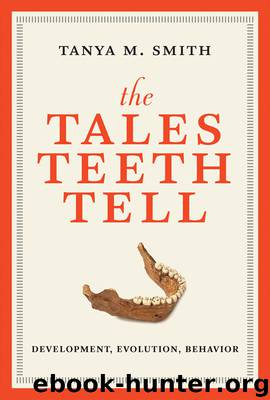The Tales Teeth Tell by Tanya M. Smith

Author:Tanya M. Smith
Language: eng
Format: epub
Tags: Dental; dentistry; paleoanthropology; biological anthropology; hominins; evolution; diet
Publisher: The MIT Press
Notes
1. The Greek philosopher Aristotle actually produced a binomial classification system more than 2,000 years before Linnaeus, introducing the concepts of genus and species, as well as a logic-based comparative approach to classify organisms.
2. The species name neanderthalensis reflects the combination of “Neander” and “thal” (meaning “valley” in German); thus this name refers to the members of the genus Homo that originated from the Neander Valley. When the German language was modernized, the letter “h” was removed from the spelling of “thal,” leading some to refer to this group as “Neandertals.” While casual reference to either “Neanderthal” or “Neandertal” is accepted by paleoanthropologists, the formal name Homo neanderthalensis retains the original spelling, following the formal rules of taxonomic classification.
3. For more information, see John Reader, Missing Links: In Search of Human Origins (Oxford, UK: Oxford University Press, 2011); David Young, The Discovery of Evolution (Cambridge, UK: Cambridge University Press, 2007).
4. Dubois originally named the fossils from Java Pithecanthropus erectus, meaning “upright ape-like human,” but the generic name Pithecanthropus was eventually disregarded since it was determined that this species was similar enough to other species in the genus Homo to be formally included. For more information, see Pat Shipman and Paul Storm, “Missing Links: Eugène Dubois and the Origins of Paleoanthropology,” Evolutionary Anthropology 11 (2002): 108–116; John de Vos, “The Dubois Collection: A New Look at an Old Collection,” Scripta Geologic, Special Issue 4 (2004): 267–285.
5. Kira E. Westaway et al., “An Early Modern Human Presence in Sumatra 73,000–63,000 Years Ago,” Nature 548 (2017): 522–525. Also see the original description in D. A. Hoiijer, “Prehistoric Teeth of Man and of the Orang-utan from Central Sumatra, with Notes on the Fossil Orang-utan from Java and Southern China,” Zoologische Mededeelingen 29 (1948): 175–301.
6. Pat Shipman and Paul Storm, “Missing Links: Eugène Dubois and the Origins of Paleoanthropology.”
7. Many anthropologists consider that a fossil is a “hominin” when it has been shown to have any adaption for bipedal locomotion, irrespective of whether the majority of its skeletal features are ape-like. We will adopt this inclusive definition here for simplicity. When using “human” I refer only to Homo sapiens, as this is the only hominin species that possesses the full suite of traits that are found in living humans today.
8. Discussed further in Tanya M. Smith, Anthony J. Olejniczak, Stefan Reh, Donald J. Reid, and Jean-Jacques Hublin, “Brief Communication: Enamel Thickness Trends in the Dental Arcade of Humans and Chimpanzees,” American Journal of Physical Anthropology 136 (2008): 237–241.
9. Discussed further in Isabelle De Groote et al., “New Genetic and Morphological Evidence Suggests a Single Hoaxer Created ‘Piltdown Man,’” Royal Society Open Science 3 (2016): 160328.
10. Gerrit S. Miller, “The Piltdown Jaw,” American Journal of Physical Anthropology 1, no. 1 (1918): 25–52, with plates.
11. An interesting historical perspective is given by the founder of the American Journal of Physical Anthropology in the article preceding Miller’s: Aleš Hrdlička, “Physical Anthropology: Its Scope and Aims; Its History and Present Status in America,” Journal of Physical Anthropology 1, no. 1 (1918): 3–23.
Download
This site does not store any files on its server. We only index and link to content provided by other sites. Please contact the content providers to delete copyright contents if any and email us, we'll remove relevant links or contents immediately.
| Anatomy | Animals |
| Bacteriology | Biochemistry |
| Bioelectricity | Bioinformatics |
| Biology | Biophysics |
| Biotechnology | Botany |
| Ecology | Genetics |
| Paleontology | Plants |
| Taxonomic Classification | Zoology |
Sapiens: A Brief History of Humankind by Yuval Noah Harari(14319)
The Tidewater Tales by John Barth(12625)
Mastermind: How to Think Like Sherlock Holmes by Maria Konnikova(7278)
Do No Harm Stories of Life, Death and Brain Surgery by Henry Marsh(6905)
The Thirst by Nesbo Jo(6877)
Why We Sleep: Unlocking the Power of Sleep and Dreams by Matthew Walker(6654)
Life 3.0: Being Human in the Age of Artificial Intelligence by Tegmark Max(5512)
Sapiens by Yuval Noah Harari(5322)
The Longevity Diet by Valter Longo(5040)
The Body: A Guide for Occupants by Bill Bryson(5027)
The Rules Do Not Apply by Ariel Levy(4910)
The Immortal Life of Henrietta Lacks by Rebecca Skloot(4548)
Animal Frequency by Melissa Alvarez(4424)
Why We Sleep by Matthew Walker(4394)
The Hacking of the American Mind by Robert H. Lustig(4338)
Yoga Anatomy by Kaminoff Leslie(4332)
All Creatures Great and Small by James Herriot(4269)
Double Down (Diary of a Wimpy Kid Book 11) by Jeff Kinney(4240)
Embedded Programming with Modern C++ Cookbook by Igor Viarheichyk(4141)
